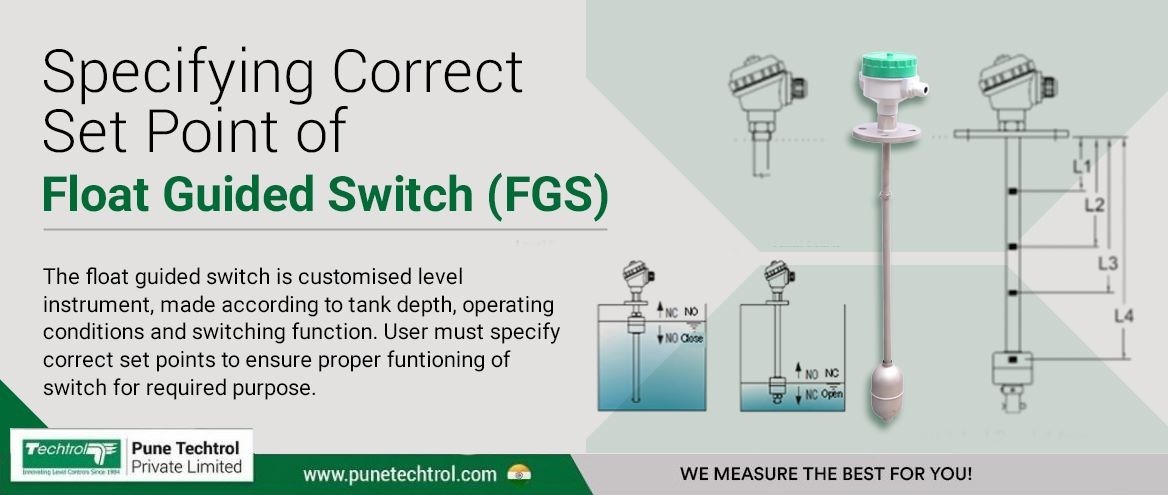Techtrol Glass Type Level Gauges for Visual Level Indication of Liquids
TYPES OF LEVEL GAUGES
Level gauges, also termed as level indicators are widely used in industry for visual level indication of liquids in process equipment like storage tanks or process vessels or drums.
Broadly, they are classified as Glass Type Level Gauges and Float Type Level Gauges. Being a mechanical instrument, they do not require electric supply for their operation.
In several applications, provision of direct reading level gauges is mandatory as statutory requirement.
Various types of glass gauges and float gauges are available, selection of gauge for particular application is based on operating conditions (max. pressure & temperature), process liquid, mounting position and measurement accuracy.
1. Glass Type Level Gauges
Advantages
- Simple to use and install
- No calibration is required
- ‘Seeing is believing’, hence reliable and do not depend on electric power
- Provides direct indication of liquid level.
- Tempered/ toughened borosilicate glass is acid & alkali resistant and withstand thermal & mechanical shocks
- Suitable for high temperature and pressure applications.
Limitations
- They are suitable for clean and free flowing liquids.
- Glass gauges have a fragile element like glass tube or flat glass.
1.1 Tubular Level Gauge (TTG)
It is most cost effective and reliable level gauge used for direct reading of liquid level in tank under low pressure. It is also used as sight glass or calibration pot to determine pumping flow rate in dosing tanks.
Operating Principle:
Communicating with Vessels. (Liquid seeks its own level)
Construction: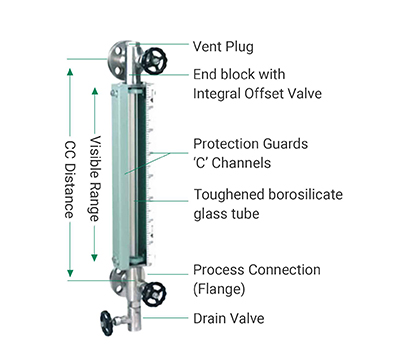
It consists of heavy wall toughened borosilicate glass tube fitted between two end blocks at top and bottom. The guards, two C channel frames or four tie rods are provided to protect gauge glass and prevent it from accidental blows. Gauge glasses are available in 16 mm, 19 mm or 25 mm OD. For viscous liquids, large diameter glass tube is used.
The end blocks are fitted with process flange through which gauge can be fitted on the tank.
End blocks are provided with integral offset needle valves, which permits cleaning of gauge glass and its removal online. Ball check facility is provided to minimise liquid loss in the event of glass breakage.
Vent valve /plug is provided at top for venting air and drain valve or plug is provided at bottom for draining the liquid in the gauge.
Tubular level gauges are available in CS, SS304/316, PP, PVDF, PTFE lined SS304 material to suit service liquid. They are suitable for maximum temperature of 200°C and maximum pressure of 10 Kg/ cm2
Tubular Level Gauges manufactured by Pune Techtrol are CE approved. IBR approved gauges, Marine approved gauges are available on demand.
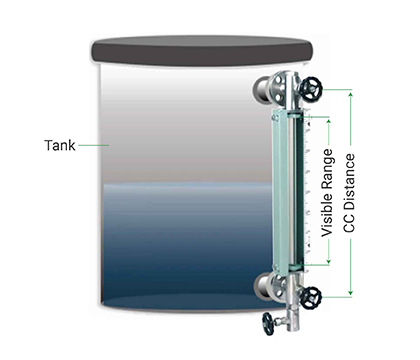 Installation and Working:
Installation and Working:
The gauge is mounted parallel to the side of the tank to form close loop by which the level of liquid in the tank is displayed in the level gauge. Thus liquid level can be observed through a gauge glass.
It is recommended to use isolation valve between gauge and tank to isolate the gauge during maintenance.
In case of large tanks, gauge can be mounted in coupler arrangement or staggered arrangement as shown in attached photo.


Additional Features:
provided with gauges are to suit the application
Glass protector: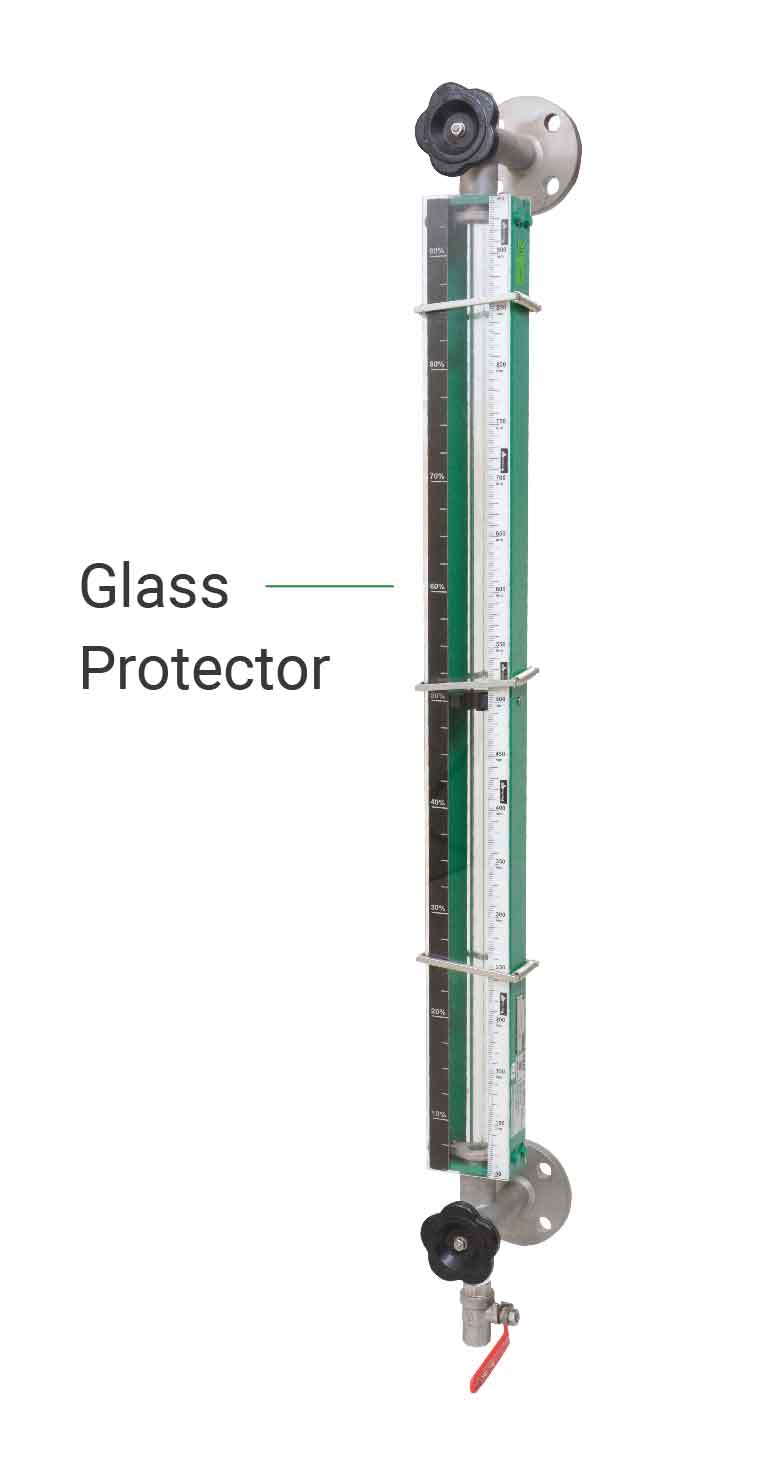
For extra protection of gauge glass and personal safety. Acrylic sheet is fitted on rear and front side with clamps to protect the gauge glass.
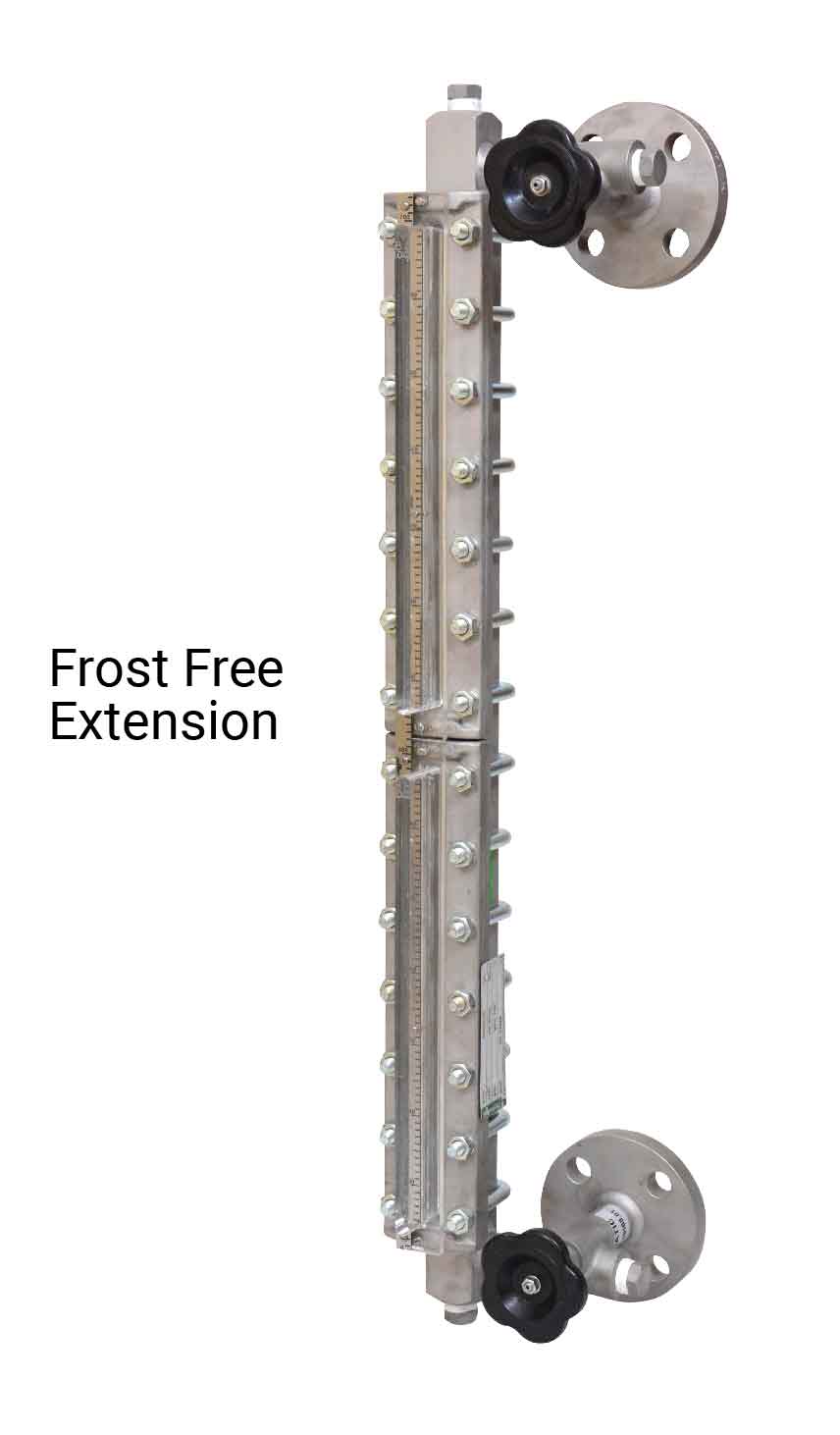 Frost free extension:
Frost free extension:
It is used for low temperature applications, where frost may build up around the outer part of gauge glass, which affect clear visibility of liquid level. A Perspex sheet is fitted with direct contact on gauge glass to prevent frost formation and liquid level indication is clearly visible through the frost extension.
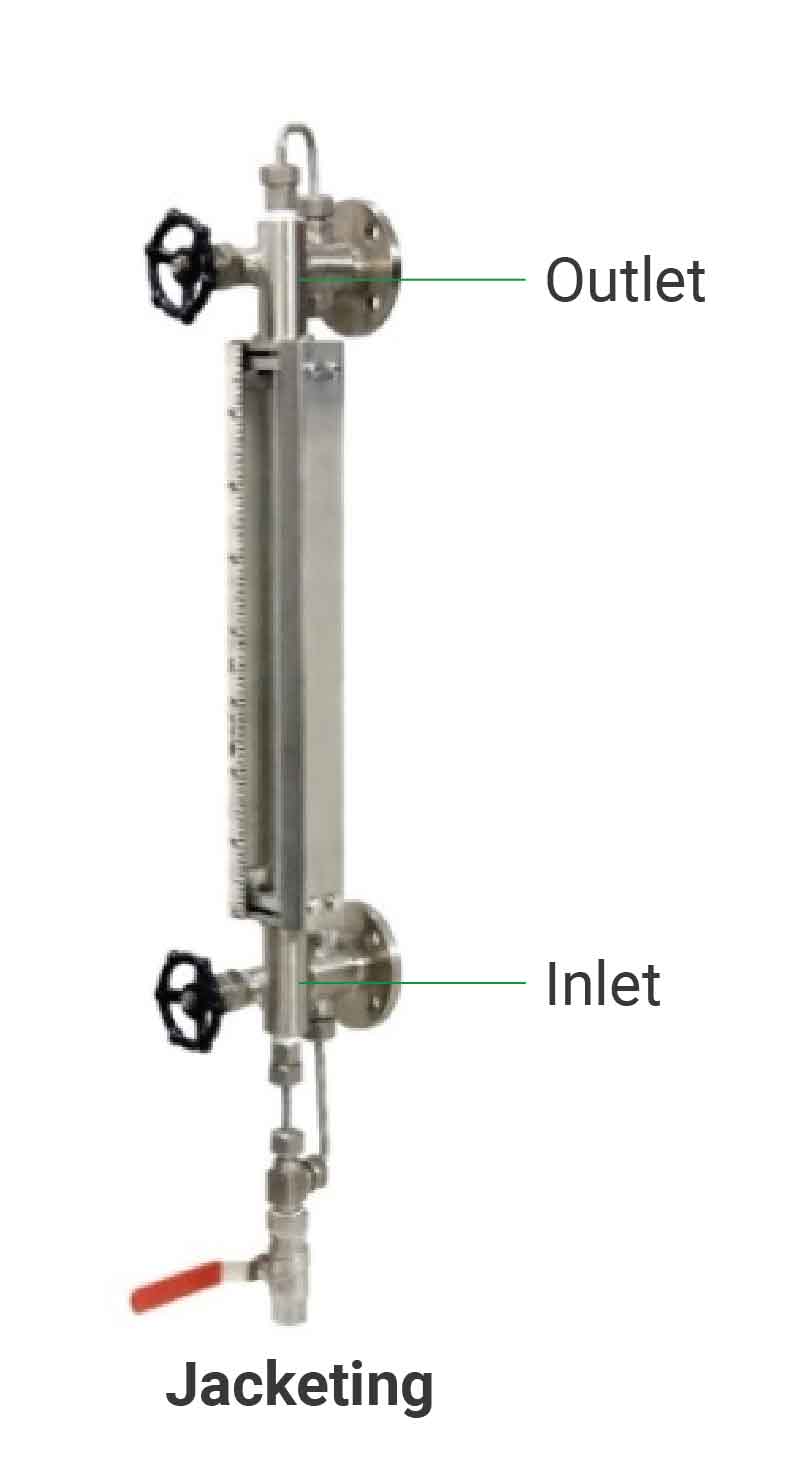
Jacketing:
For heating/cooling of process liquid to prevent its solidification. Hot water/steam or refrigerant like Freon, Propane or Ammonia can be passed internally through SS inlet pipe to maintain process liquid in fluid state.
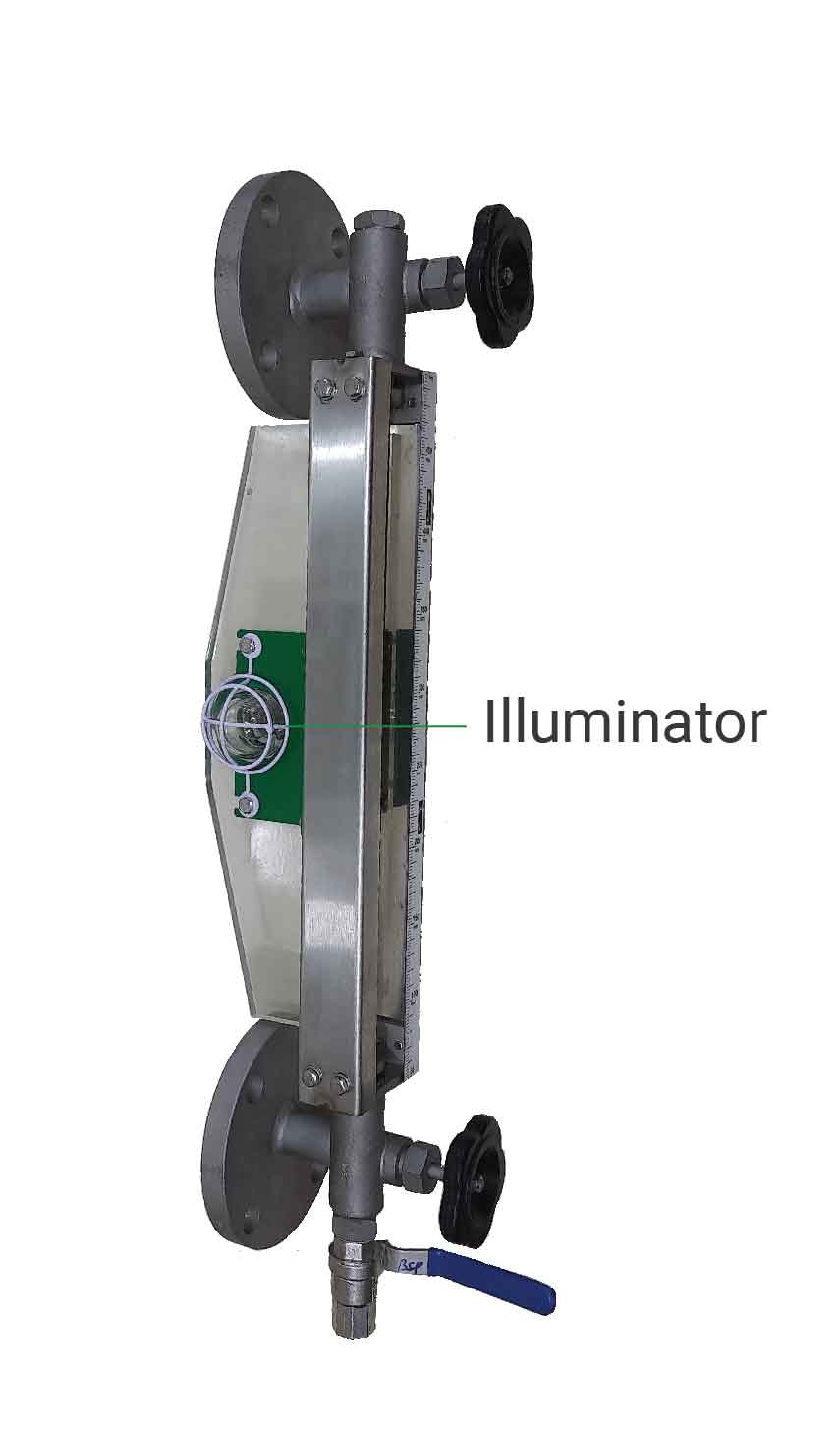
Illuminator:
For better visibility in poorly lit area. LED bulb with Perspex sheet is fitted on rear side of gauge glass to provide uniform light along the length of gauge glass for better visibility. Weather proof or flameproof enclosures are available for electrical termination.
Applications:
Storage /process tanks of water, brine, oils, solvents, alcohol, diesel. Dosing tanks of acids & alkalis in WTPs, STPs and ETPs.
1.2 Reflex Flat Glass Gauge (RFG)
It is an armoured and robust level gauge designed for distinct positive visual indication of liquid level in vessels under high temperature and pressure. It is suitable for clean and colourless liquids.
Operating Principle:
Communicating with vessels, reflection and refraction of light.
Construction: fig a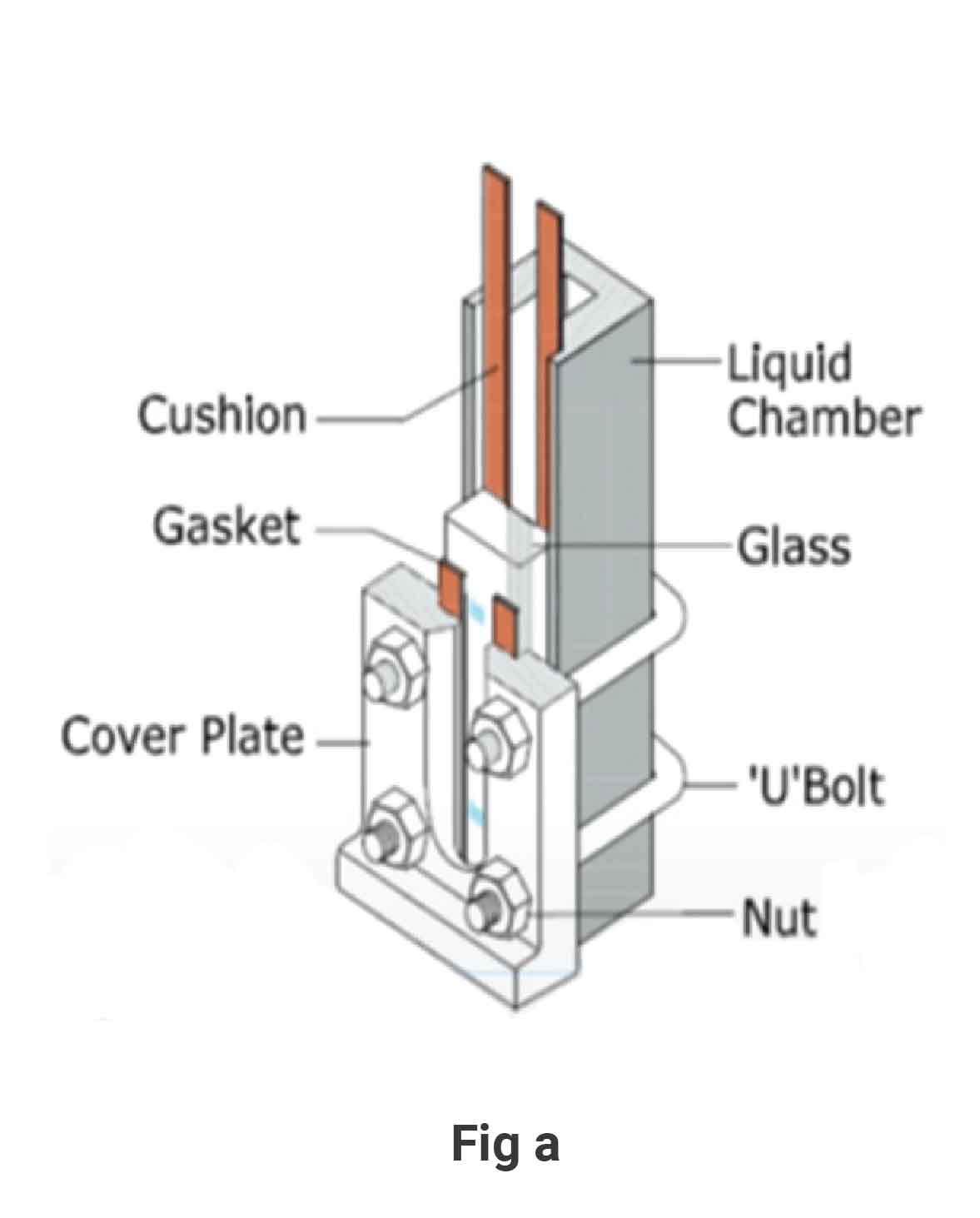
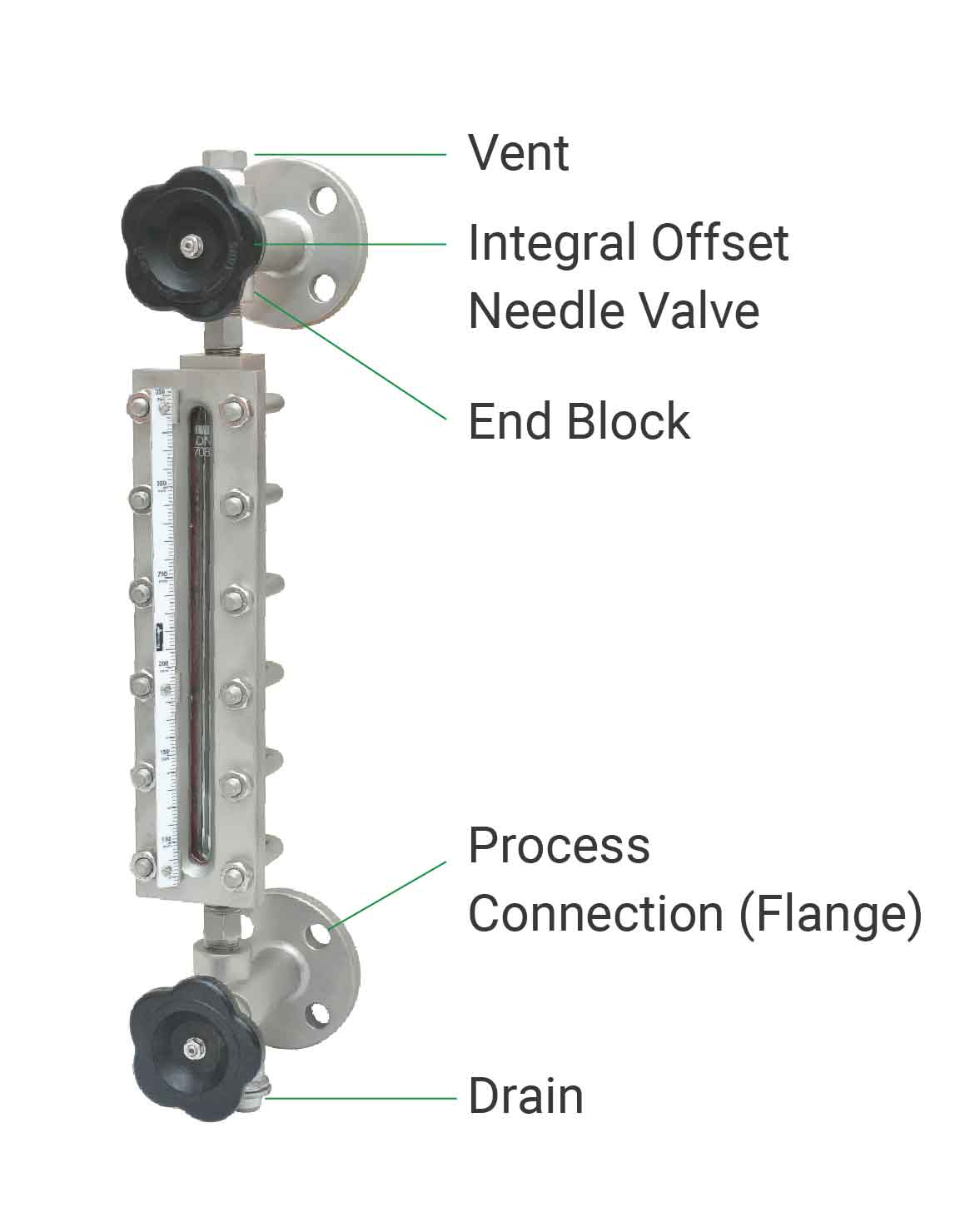
It consists of toughened borosilicate reflex flat glass whose inner surface has precisely moulded prismatic grooves cut on it and a bar stock liquid chamber with exactly machined single or multiple slots equal to the size of glass. The inner surface of flat glass is placed on the races/slots of liquid chamber alongwith cushion. Cover plate alongwith gasket is placed on the glass and whole assembly is held together by ‘U’ bolts & nuts, which provides uniform compression load to the gauge (Refer adjacent figure). Cushions & gaskets protect the gauge glass form mechanical stresses from cover plate.
The end blocks with process connections are fitted at top & bottom of the liquid chamber or they can be connected to the side of the chamber to get full visible range equal to CC distance.
Offset type gauge cocks/ valves are integral part of the end blocks. They are used to isolate the tank from gauge and permits cleaning of gauge glass and its removal online. Ball check facility is provided to minimise liquid loss at the event of glass breakage.
Vent valve /plug is provided at top for venting air and drain valve or plug is provided at bottom for draining the liquid in the gauge.
Reflex gauges are available in CS, A105, SS304/316/316L, SA516, Super Duplex, PP or CS rubber lined material to suit service liquid.
Reflex gauge are suitable to use for maximum temperature of 400°C and maximum pressure of 210 Kg/ cm2
Reflex Flat Glass Gauges manufactured by Pune Techtrol are CE approved. IBR approved gauges, Marine approved gauges are available on demand.
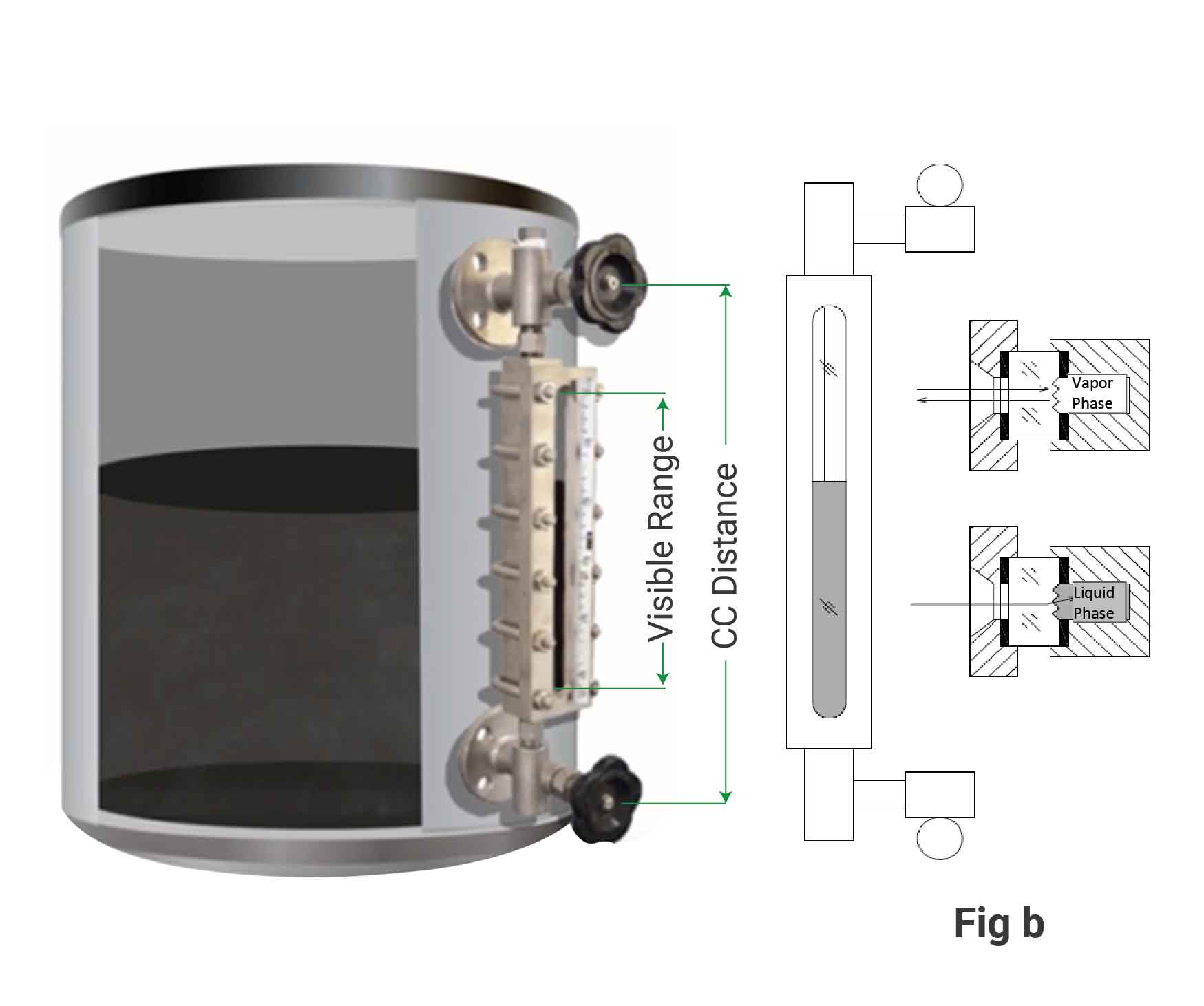 Installation & Working: fig b
Installation & Working: fig b
The gauge is mounted parallel to the side wall of the tank. The portion of the gauge-glass covered with liquid appears black as light gets refracted within liquid while passing through liquid and the prismatic grooves, whereas the glass portion above liquid level covering vapour or steam appears silvery-white. Thus eliminates all the possible errors that occur while reading liquid level.
It is recommended to use isolation valve between gauge and tank to isolate the gauge during maintenance.
In case of large tanks, gauge can be mounted in coupler or staggered arrangement.
Additional Features: provided with gauge are as under
- Frost free extension: Is used for low temperature applications where frost may build up around the outer part of gauge glass, which affect clear visibility of liquid level. A Perspex sheet is fitted with direct contact on gauge glass to prevent frost formation and liquid level indication is clearly visible through the frost extension.
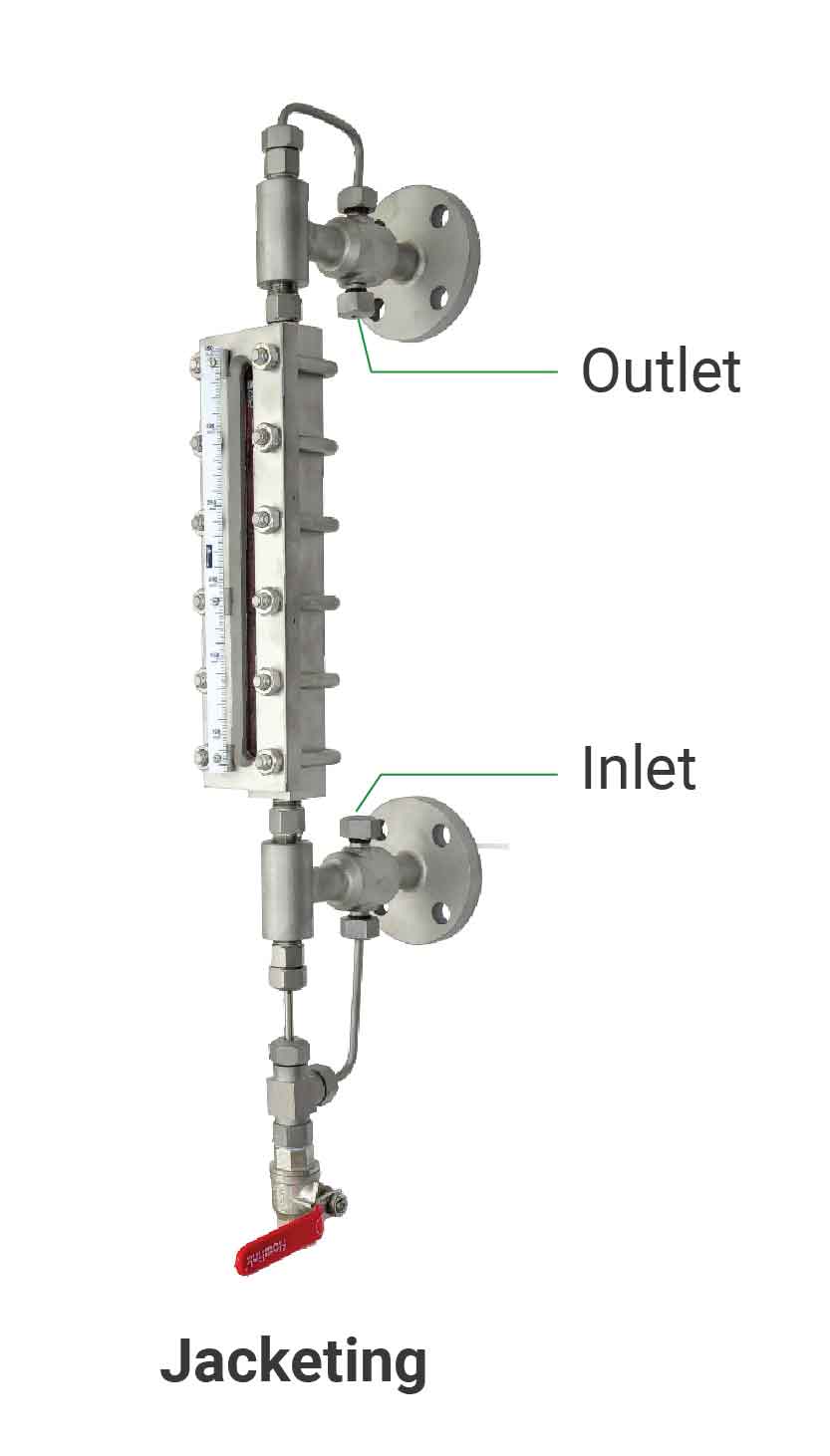
- Jacketing:
For heating/cooling of process liquid to prevent its solidification. This is less expensive method where hot water/steam or refrigerant like Freon, Propane or Ammonia can be passed internally through SS inlet pipe to maintain process liquid in fluid state.
Applications:
- Storage or process tanks of water, brine, ammonia, chemicals, oils and diesel.
- Dosing tanks of acids and alkalis in water treatment, effluent treatment plant.
- Steam condensate, feed water, hot water, steam drum in power plants
1.3 Transparent Flat Glass Gauge (TFG)
It is an armoured and robust level gauge, designed to provide safe and positive indication of liquid level in the tank under high temperature and pressure conditions. It is used for colored, corrosive, interface liquids or steam services.
Operating Principle:
Communicating with vessels
Construction: fig c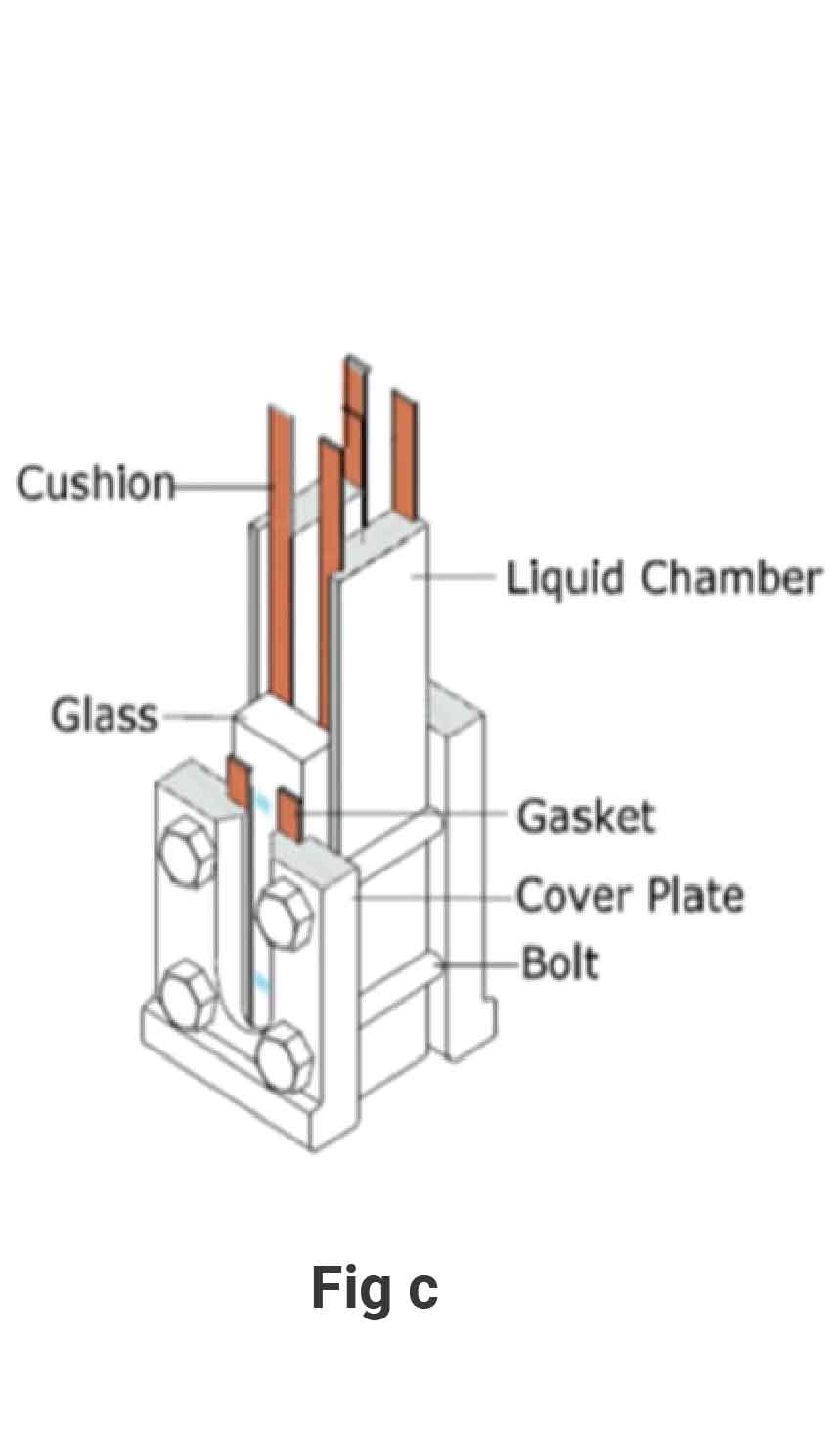
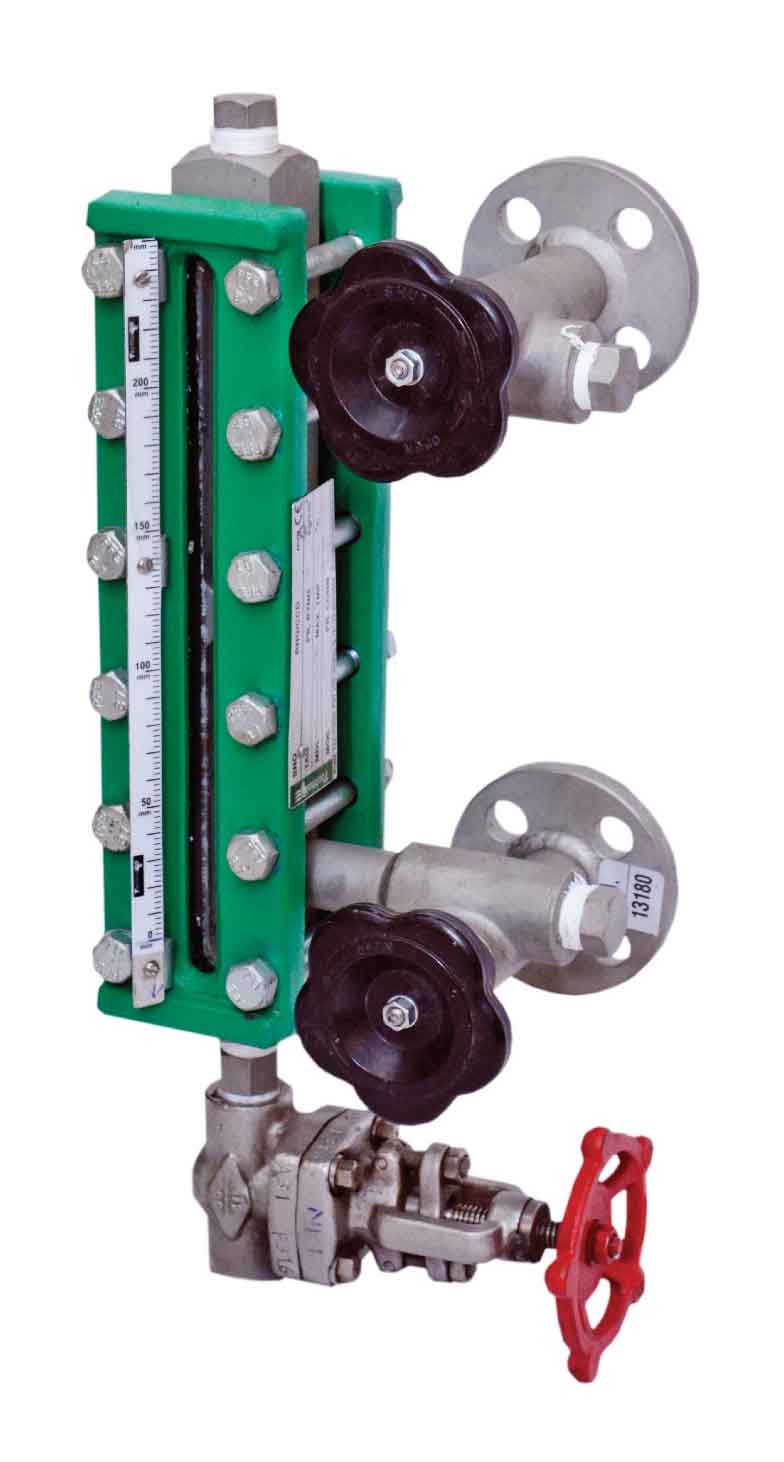
It consists of toughened borosilicate transparent flat glass and a liquid chamber with exactly machined single or multiple slots equal to the size of glass. The transparent glass is flat from both sides. Two glasses alogwith cushions are placed on the precisely machined races/slots of liquid chamber from both front and rear side. Cover plates alongwith gaskets are placed on the glass from both sides and whole assembly is held together using nuts & bolts, which provides uniform compression load to the gauge (Refer adjacent figure). Cushions & gaskets protect the gauge glass from mechanical stresses from cover plate. The end blocks with process connections are fitted at top & bottom of the liquid chamber or they can be connected to the side of the chamber to get full visible range equal to CC distance.
End blocks are provided with integral offset needle valves, which permit cleaning of gauge glass and its removal online. Ball check facility is provided to minimise liquid loss at the event of glass breakage.
Vent valve /plug is provided at top for venting air and drain valve or plug is provided at bottom for draining the liquid in the gauge.
Transparent gauges are available in CS, A105, SS304/316/316L, SA516, Super Duplex or CS rubber lined material to suit service liquid.
Transparent level gauges are suitable to use for maximum temperature of 400°C and maximum pressure of 210 Kg/ cm2
Transparent Flat Glass Gauges manufactured by Pune Techtrol are CE approved. IBR approved gauges are available on demand.
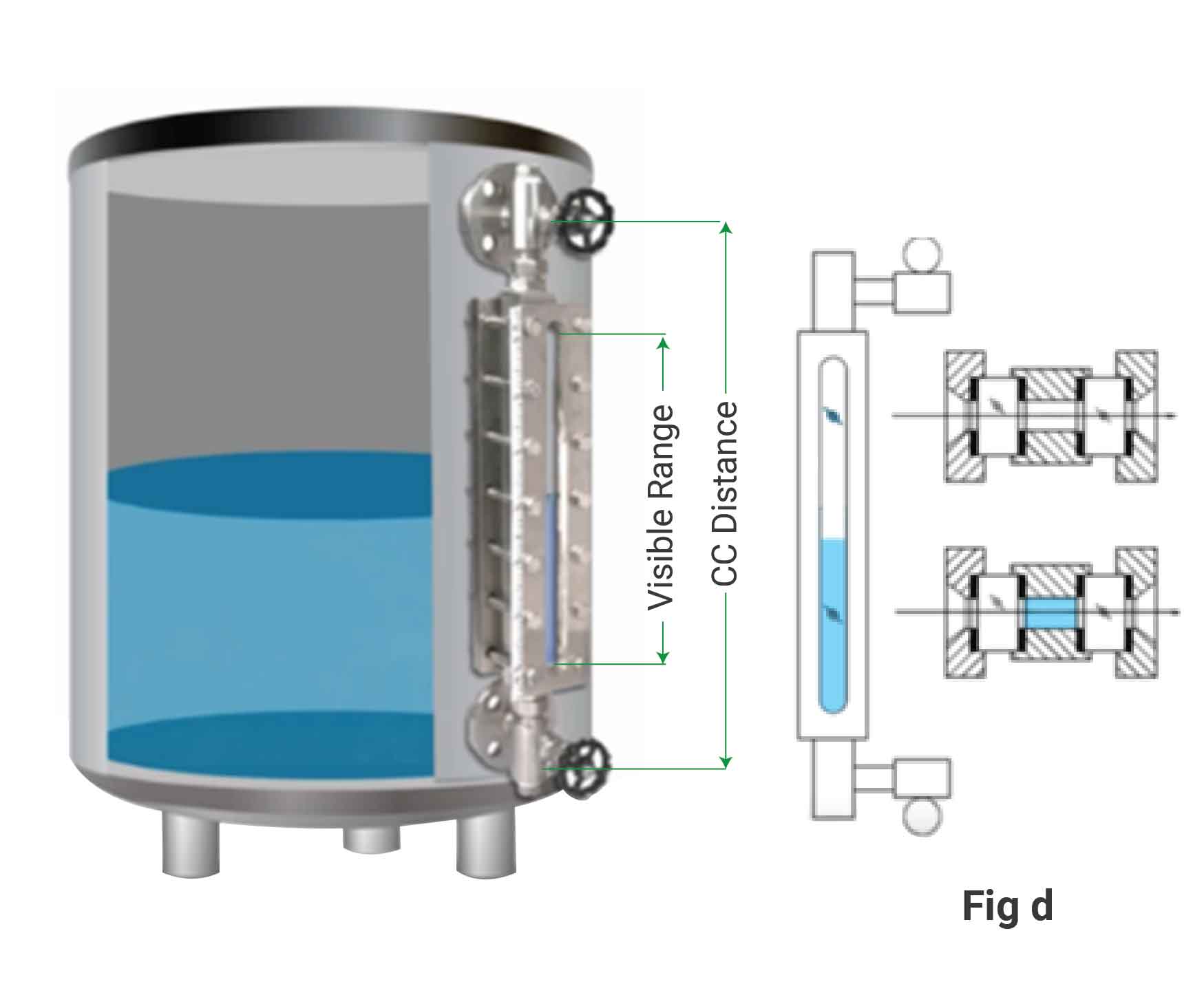 Installation & Working: fig d
Installation & Working: fig d
The gauge is mounted parallel to the side of the tank. It is recommended to use isolation valve between gauge and tank to isolate the gauge during maintenance.
It provides direct indication of liquid level through the two crystal clear, flat, transparent glasses fitted on rear and front side of the gauge. In case of large tanks, gauge can be mounted in coupler arrangement or staggered arrangement.
Additional Features:
Provided with gauge to suit application requirements.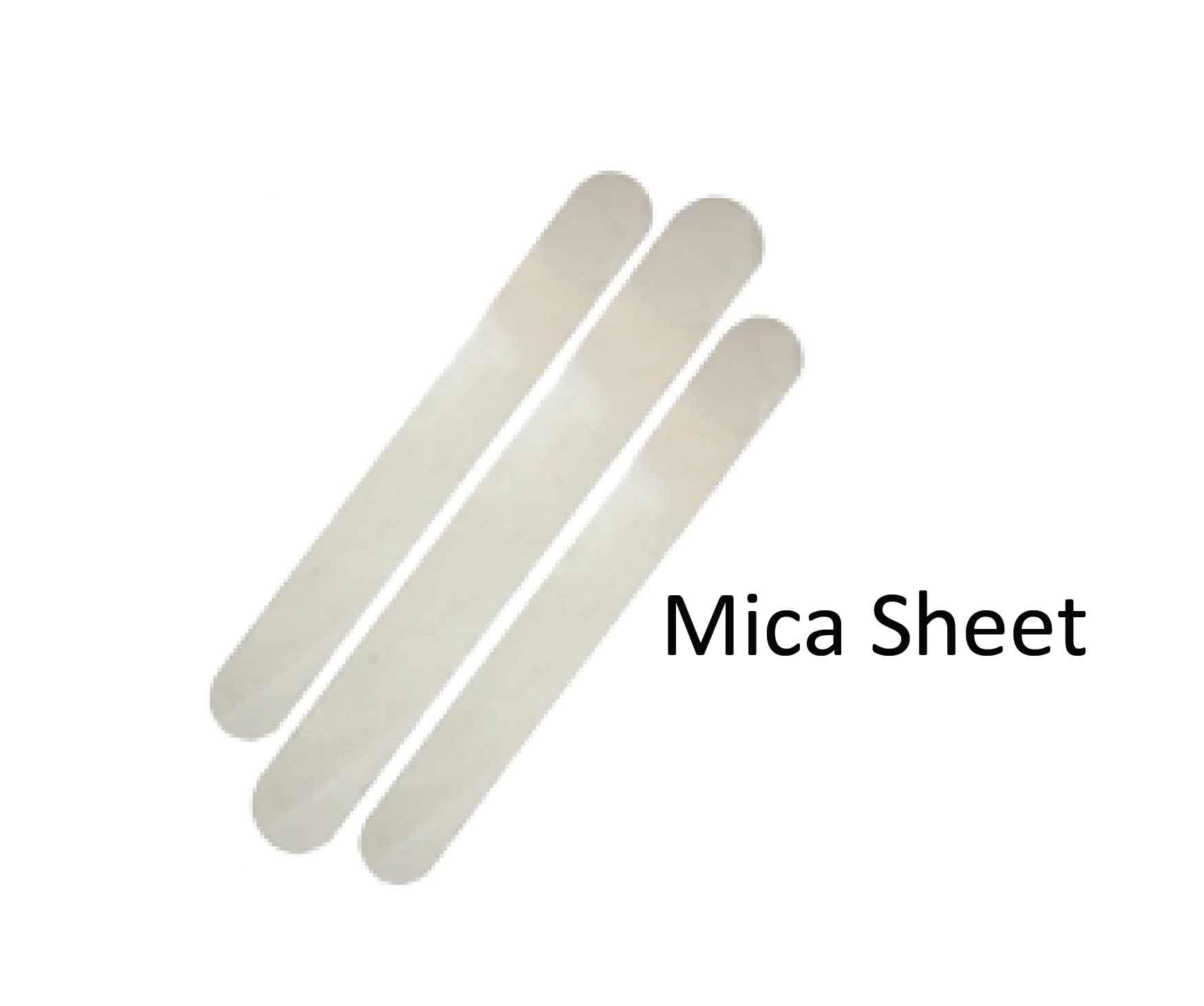
1. Mica Sheet: Mica sheets are placed on process side of liquid to protect glass from steam service and extends its life.
2. Frost free extension: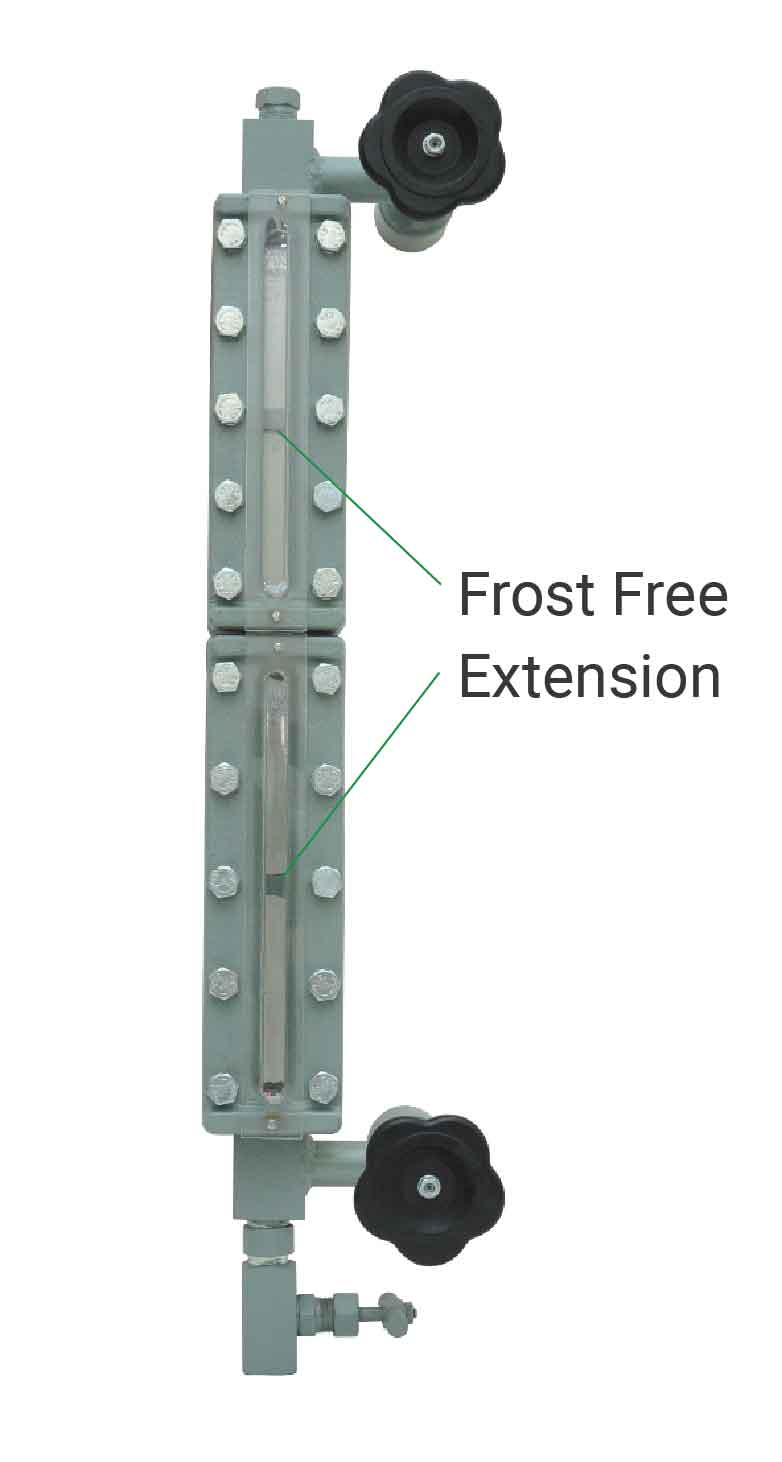
It is used for low temperature applications where frost may build up around the outer part of gauge glass, which affect lear visibility of liquid level. A Perspex sheet is fitted with direct contact on gauge glass to prevent frost formation and liquid level indication is clearly visible through the frost extension.
3. Jacketing:
For heating/cooling of process liquid to prevent its solidification. This is less expensive method where hot water/steam or refrigerant like Freon, Propane or Ammonia can be passed internally through SS inlet pipe to maintain process liquid in fluid state.
4.Illuminator: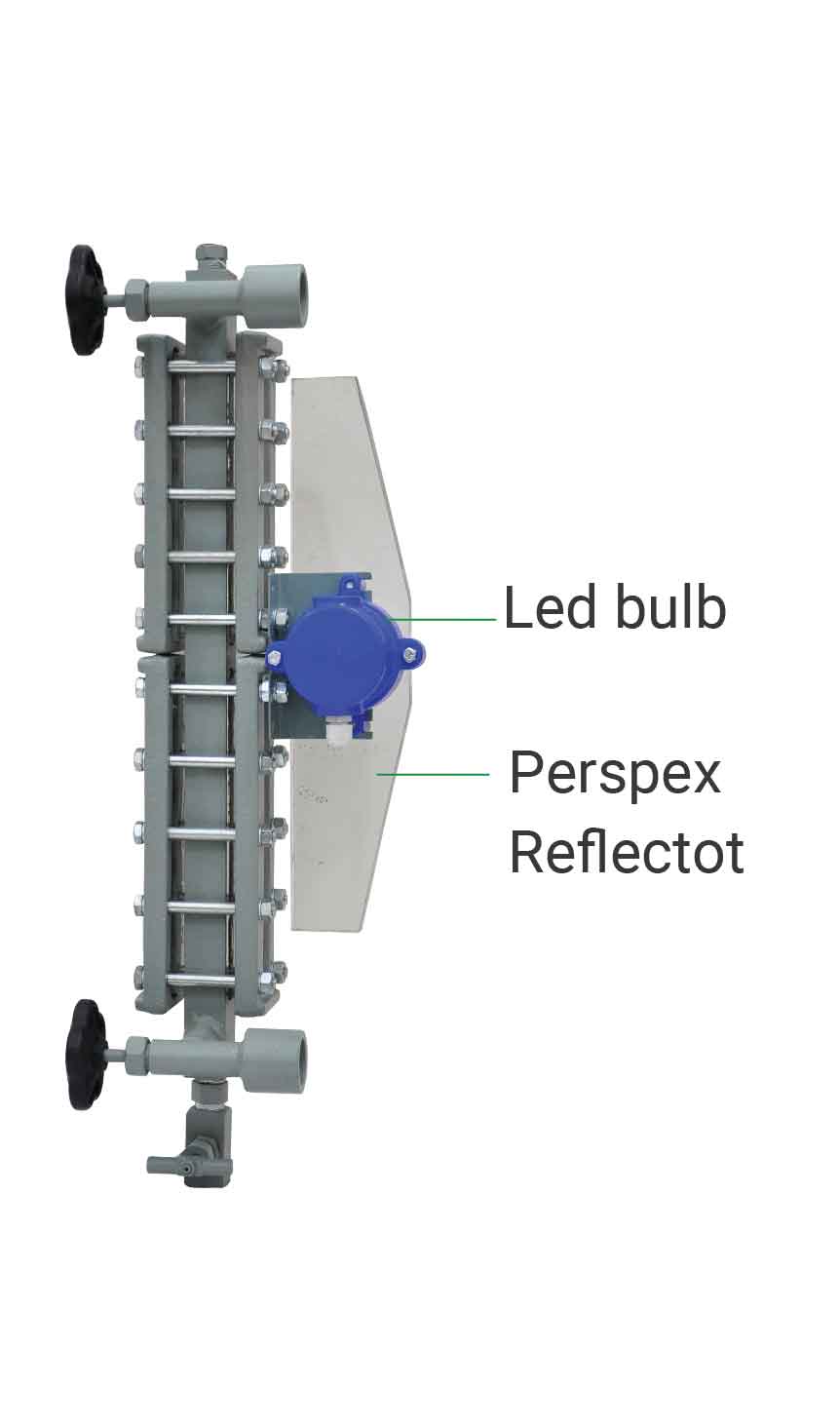
LED bulb with Perspex sheet is fitted on rear side of gauge glass to provide uniform light along the length of gauge glass in poorly lit area. Weather proof or flameproof enclosures are available for electrical termination.
Applications:
-Storage /process tanks of water, acids, alkalis, oils, hydrocarbon and diesel.
-high pressure vessels like Accumulator, condenser
-Steam condensate, feed water, hot water, steam drum in power plant.
1.4 Weld Pad Flat Glass Level Gauge (WFG)
It is robust, armoured level gauge designed for safe and positive visual indication of liquid level in tanks having space limitations and where conventional process connection cannot be used. They are directly welded on tank so as to become its integral part. Weld pad gauges are provided in reflex glass and are used as sight glass for visual indication of clean & clear liquids and oils.
Operating Principle:
Communicating with vessels, reflection and refraction of light.
Construction: fig e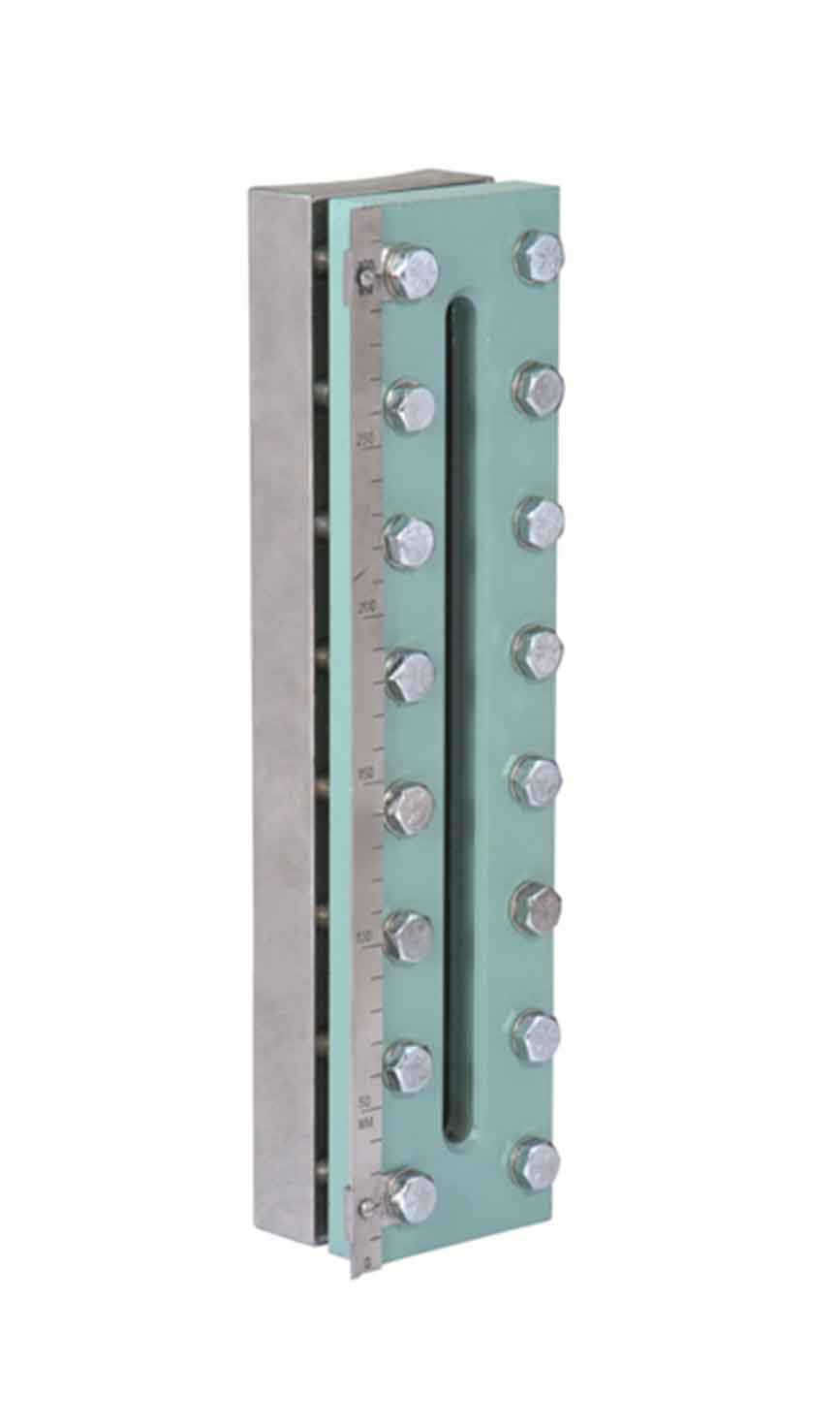
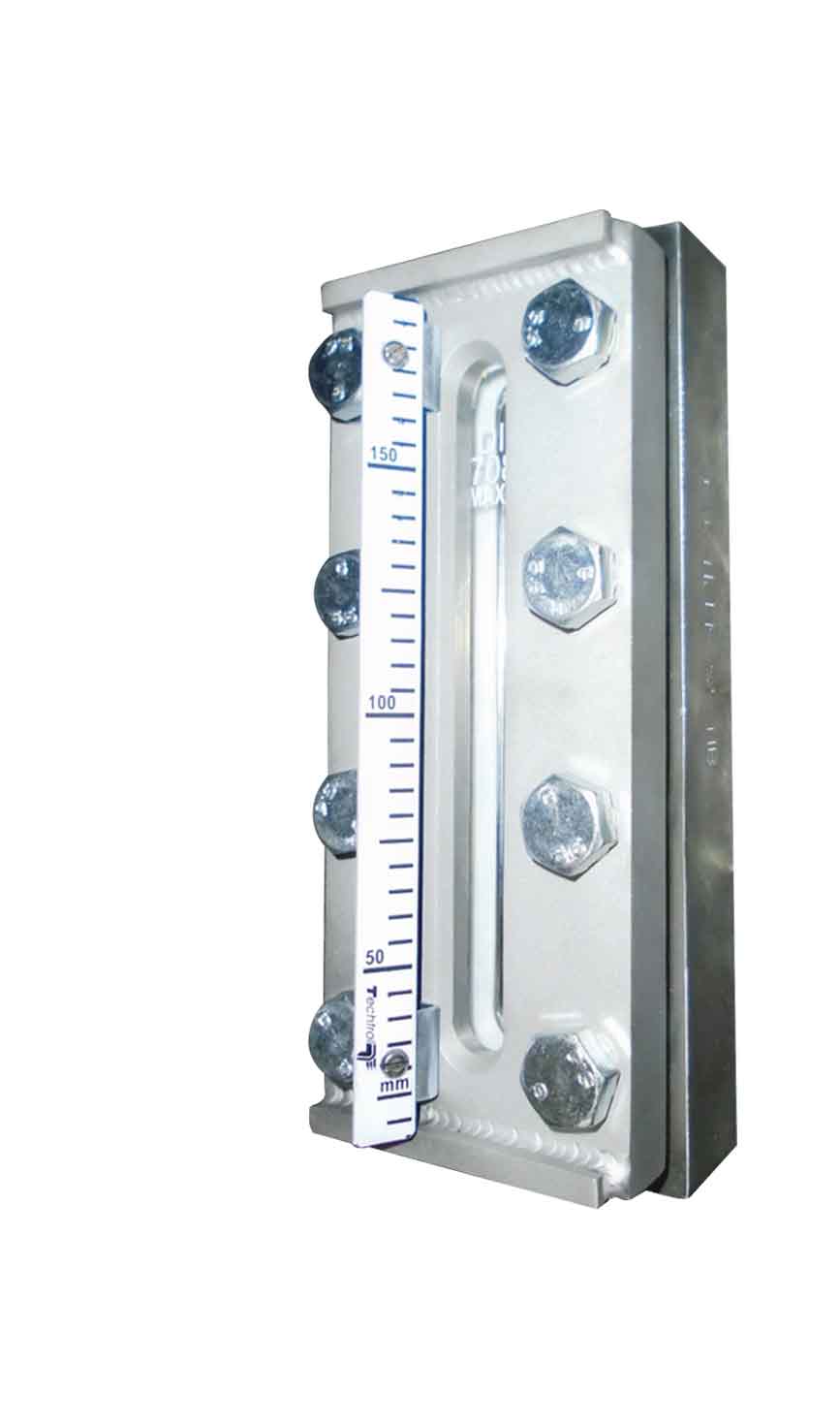
It consists of toughened borosilicate reflex flat glass, whose inner surface has precisely moulded prismatic grooves cut on its inner side and a liquid chamber with exactly machined single or multiple slots equal to the size of glass. Liquid chambers are available with flat or curved pads to suit tank surface contour and holes are drilled on it for inflow and outflow of liquid. The grooved surface of flat glass is placed on the slots of liquid chamber alongwith cushion. Cover plate alongwith gasket is placed on the glass and whole assembly is held together using nuts & bolts, which provides uniform compression load to the gauge (Refer adjacent figure e) Cushions & gaskets protect the gauge glass form mechanical stresses from cover plate.
Weld pad gauges are available in CS, A105, SS304/316/316L to suit service liquid and are suitable for maximum temperature of 300°C and maximum pressure of 150 Kg/ cm2
Weld pad Flat Glass Gauges manufactured by Pune Techtrol are CE approved.
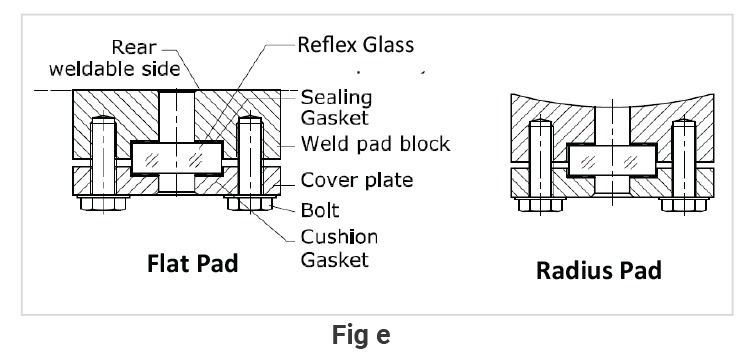
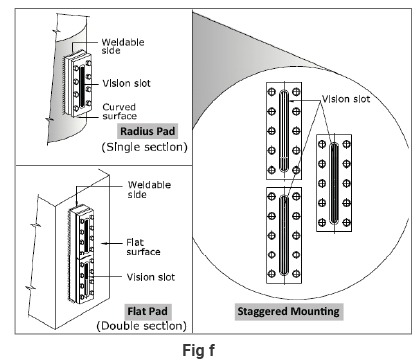
Installation & Working: fig f
The gauge is directly welded on outer wall of the tank so as to form integral part of it. For large tanks gauge can be mounted in staggered manner as shown in adjacent figure. Similar to reflex level gauge, glass portion covered with liquid appears as black and portion above it (vapour space) appears as silvery white.
Additional Features (Frost free extension):
A Perspex sheet is fitted on glass gauge for clear visual reading of liquid level at low temperature due frost formation.
Applications:
Mineral Oils, Water, Hydrocarbons & Chemicals in Water Treatment & Power Plants, Chemical & Petrochemical industries and Marine industry.
1.5 Bi-colour Multiport Level Gauge
It is reliable, direct indication type level gauge used in high pressure boiler applications for clear and distinct indication of water level in green colour and steam in red colour.
The gauge with multiport design minimises the chances of glass breakages and increases the structural robustness of gauge as the impact of high internal pressure and temperature is distributed uniformly to each of the port.
Operating Principle:
Communicating vessels, difference in refractive index of light through water and steam.
Construction: fig g & fig h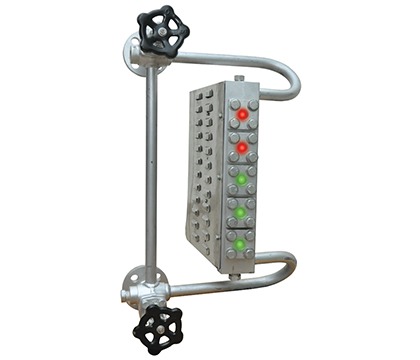
Vent and drain valves are fitted at top & bottom side of the liquid chamber respectively. An illuminator housing consisting of green & red coloured filter glass and LED bulbs are fitted on rear side of liquid chamber. Display hood is provided optionally, which is fixed on front side to enable better visibility without ambiguity.
It consists of trapezoid shaped liquid chamber with equi-spaced ports along its two nonparallel sides. Tempered & toughened borosilicate gauge glasses are flat and circular in shape. The gauge glass with high quality mica sheets are fitted on each port with gaskets and cushions. Mica sheet protect the inner surface of glass and prevent its erosion due to steam. Port covers are fitted on each port with bolts to protect glass and provide uniform compression load to the gauge. Refer adjacent port assembly (figure g). Two end blocks comprising integral offset needle valve and ball check facility are connected to liquid chamber through single or double expansion loops at top and bottom side. Process connections are fitted to end blocks by which the gauge is fitted on the tank. These expansion loops works as compensators to absorb forces on gauge connections due to thermal expansion and high pressure. Stand pipe between two end blocks is provided for rigidity of the gauge and for recirculation of condensate.
Bicolour gauges manufactured by Pune Techtrol are available in CS SA516, CS A105, SS304 or SS316 material. They are suitable for high temperature upto 300 ° C and maximum pressure upto 160 kg/cm2. IBR approved gauges are available.
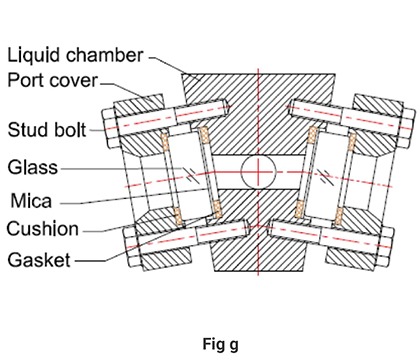
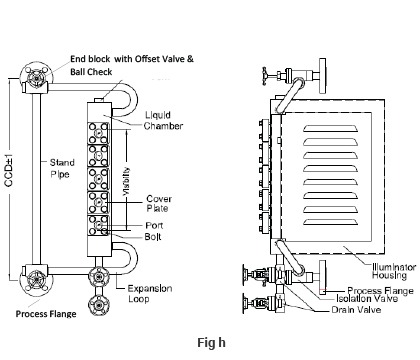
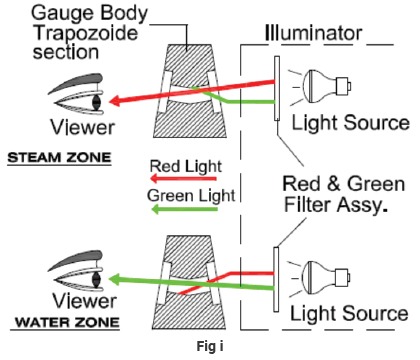
Installation and working: fig i
The gauge is mounted on side of the tank through process connections. It is recommended to use isolation valve between gauge and tank. The light rays from bulb passes through bicolour (green & red) filter and through inclined glass fitted on trapezoid shaped chamber. The coloured light rays get refracted in steam or water according to its refractive index. It appears to the viewer as red colour, when light passes through steam and green colour when light passes through water due to differences of the refractive index of water & steam. Visibility of gauge is distance between upper most and lower most glass (fig. h).
Applications:
Boiler Drum, Feed Water Heater, Dearator, Condenser Hot well, Blow-down Tanks, HP Turbine Bypass Drain Sump, Cold reheat drain sump.



